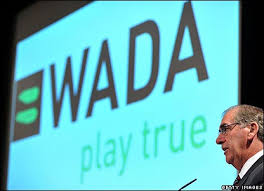The World Anti-Doping Agency's (WADA) mission is to promote, coordinate and monitor the fight against doping in sport in all its forms.

WADA was established in 1999 as an international independent agency composed and funded equally by the sport movement and governments of the world. Its key activities include scientific research, education, development of anti-doping capacities, and monitoring of the World Anti Doping Code (Code) – the document harmonizing anti-doping policies in all sports and all countries. WADA is a Swiss private law Foundation. Its seat is in Lausanne, Switzerland, and its headquarters are in Montreal, Canada. WADA works towards a vision of the world that values and fosters a doping-free culture in sport.
Funding
 WADA's funding is based on a unique hybrid private-public model:50% Olympic Movement 50 % Governments of the world.
WADA's funding is based on a unique hybrid private-public model:50% Olympic Movement 50 % Governments of the world.
The National Anti-Doping Agency (NADA) is the national organization responsible for promoting, coordinating, and monitoring the doping control programme in sports in all its forms in the country. NADA works towards a vision of ’dope free’ sport in India.Its Functions are
Cooperating with other sports related organizations and other anti-doping organizations,
Encouraging reciprocal testing between National Anti-Doping Organizations, and
Promoting anti-doping research & education.
7th Asia/Oceania Intergovernmental Meeting on Anti Doping in Sports organized by National Anti Doping Agency (NADA) India on 24th and 25th May, 2010 in New Delhi.
 WADA's funding is based on a unique hybrid private-public model:
WADA's funding is based on a unique hybrid private-public model:The National Anti-Doping Agency (NADA) is the national organization responsible for promoting, coordinating, and monitoring the doping control programme in sports in all its forms in the country. NADA works towards a vision of ’dope free’ sport in India.Its Functions are
Cooperating with other sports related organizations and other anti-doping organizations,
Encouraging reciprocal testing between National Anti-Doping Organizations, and
Promoting anti-doping research & education.
Types of performance-enhancing drugs
 Although the phrase performance-enhancing drugs is typically used in reference to anabolic steroids or their precursors, world anti-doping organizations apply the term broadly. The phrase has been used to refer to several distinct classes of drugs:
Although the phrase performance-enhancing drugs is typically used in reference to anabolic steroids or their precursors, world anti-doping organizations apply the term broadly. The phrase has been used to refer to several distinct classes of drugs:
- Lean mass builders are used to drive or amplify the growth of muscle and lean body mass, and sometimes to reduce body fat. This class of drugs includes anabolic steroids, beta-2 agonists, selective androgen receptor modulator SARMs and various human hormones, most notably human growth hormone, as well as some of their precursors.
- Stimulants are used by athletes to stimulate their bodies and perform at optimum level, usually to increase alertness, decrease fatigue, and increase aggressiveness. Examples include caffeine and amphetamines.
- Painkillers mask athletes' pain so they can continue to compete and perform beyond their usual pain thresholds. Blood pressure is increased causing the cells in the muscles to be better supplied with vital oxygen. Painkillers used by athletes range from common over-the-counter medicines such as NSAIDs (such as ibuprofen) to powerful prescription narcotics.
- Sedatives are sometimes used by athletes in sports like archery which require steady hands and accurate aim, and also by athletes attempting to overcome excessive nervousness or discomfort. Alcohol and marijuana are examples.
- Diuretics expel water from athletes' bodies. They are often used by athletes such as wrestlers, who need to meet weight restrictions. Many stimulants also have a secondary diuretic effect.
- Masking drugs are used to prevent the detection of other classes of drugs. These evolve as quickly as do testing methods - which is very quickly indeed - although a time-tested classic example is the use of epitestosterone, a drug with no performance-enhancing effects, to restore the testosterone/epitestosterone ratio (a common criterion in steroid testing) to normal levels after anabolic steroid supplementation.

Extensive doping control for CWG
Fri Sep 03 2010 08 : 09 / New DelhiCGF has approved 1500 doping control tests, 250 blood tests, 150 EPO tests and 150 pre-Competition tests – the highest ever in any Commonwealth Games.

